スコットランド2200km走破 国立スコットランド博物館17 Museum of Scotland 9 日本の浮世絵 青山貞一 Teiichi Aoyama 池田こみち Komichi Ikeda 2018年12月10日公開 独立系メディア E-wave Tokyo 無断転載禁 |
| スコットランド総目次へ* 国立スコットランド博物館物館1 国立スコットランド博物館物館2 国立スコットランド博物館物館3 国立スコットランド博物館物館4 国立スコットランド博物館物館5 国立スコットランド博物館物館5-2 国立スコットランド博物館物館6 国立スコットランド博物館物館6-2 国立スコットランド博物館物館6-3 国立スコットランド博物館物館6-4 国立スコットランド博物館物館6-5 国立スコットランド博物館物館6-6 国立スコットランド博物館物館6-7 国立スコットランド博物館物館7 国立スコットランド博物館物館7-2 国立スコットランド博物館物館8 国立スコットランド博物館物館9 国立スコットランド博物館物館10 国立スコットランド博物館物館11 ここでは国立スコットランド博物館が所蔵する浮世絵を紹介します。 日本の浮世絵 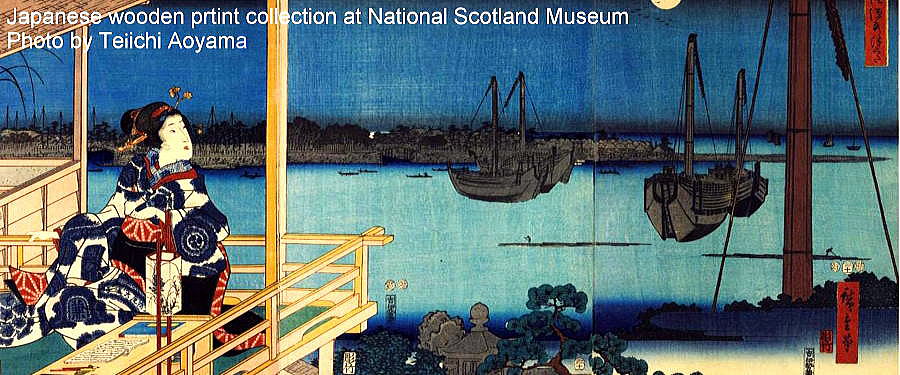 侍の宝物から小さな根付けまで、国立スコットランド博物館はたくさんの日本の美術品を収集しています。その数は新石器時代から現代までのおよそ1万点にも及んでいます。 From Samurai treasures to tiny netsuke, the National Museum of Scotland has the largest Japanese collection in Scotland. Comprising some 10,000 objects, it covers a wide range of material from the Neolithic period to the present day. Source: National Museums Scotland 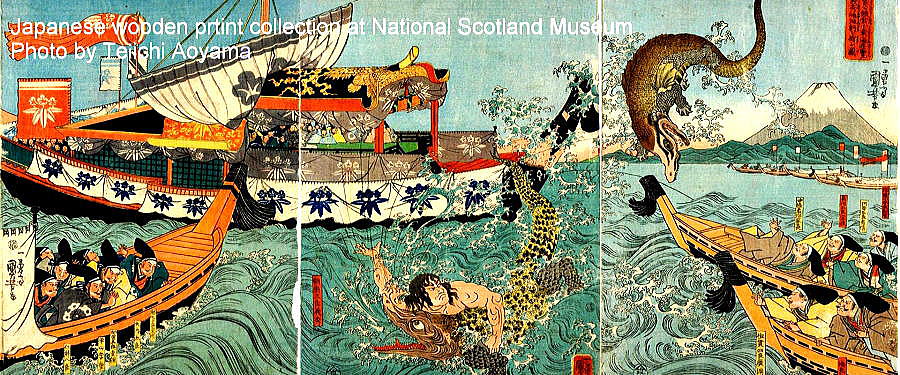 小さな根付の日本コレクションの中から最先端のデザイン、すばらしい陶芸作品、アイヌの工芸品など、いくつか目玉の作品を見てみましょう。壮大な展示物の日本の文化財コレクションには考古学、陶器、金属工芸、織物、刀剣や刀の装飾品、鎧、楽器、仏具、漆工芸品、印籠や根付などのミニチュアアート、現代のスタジオアート類などがあります。 版画及び絵画|考古学|アイヌ作品|陶磁器|武具類|衣類や織物|漆工芸|仏具工芸品|19世紀のコレクション|20世紀及び日本の現代美術作品|などが展示されている。 Explore highlights of our Japanese collection, from tiny netsuke to cutting edge designs, superb ceramics to Ainu artefacts. A spectacular array The Japanese cultural collection encompasses archaeology, woodblock prints, ceramics, metalwork, textiles, swords and sword fittings, armour, musical instruments, Buddhist items, lacquer, miniature arts, including medicine cases (inr?) and toggles (netsuke), and contemporary studio arts. Prints and paintings | Archaeology | Ainu objects | Ceramics | Arms and armour | Clothing and textiles | Lacquerware | Buddhist artefacts | 19th century collection | 20th century and contemporary Japan | The collection on display Source: National Museums Scotland  日本の近代初期の芸術の中で最も重要かつ代表的なものは浮世絵であり、およそ4000点の19世紀の色絵版画を収蔵しています。これらの作品は南ケンジントン美術館(今日のヴィクトリア・アルバート美術館)と1887年に共同購入したものです。これらは、4つの主要なジャンル(武士/戦士、風景、美人及劇場)をすべてカバーしており、国芳、国貞、広重などの著名な画家の作品の多くを集めています。また、この中には、およそ30題にも及ぶ絵を一冊にした版画本も含まれています。最近は、近代初期の掛け軸の絵画、画集、屏風などの収集を目的としています。 From Japan’s early modern period the most substantial representation is pictorial art, with around 4,000 colour woodblock prints dating from the 19th century. These were part of a joint purchase with the South Kensington Museum (today’s Victoria and Albert Museum) in 1887. They cover the four major print genres ? warriors, landscapes, beauties and theatre ? with the majority of works being by the renowned artists Kuniyoshi, Kunisada and Hiroshige. The group also includes some woodblock-printed books, numbering about 30 titles. More recently, collecting has aimed to increase the representation of early modern paintings, in hanging scroll, handscroll, album and folding screen formats. Source: National Museums Scotland 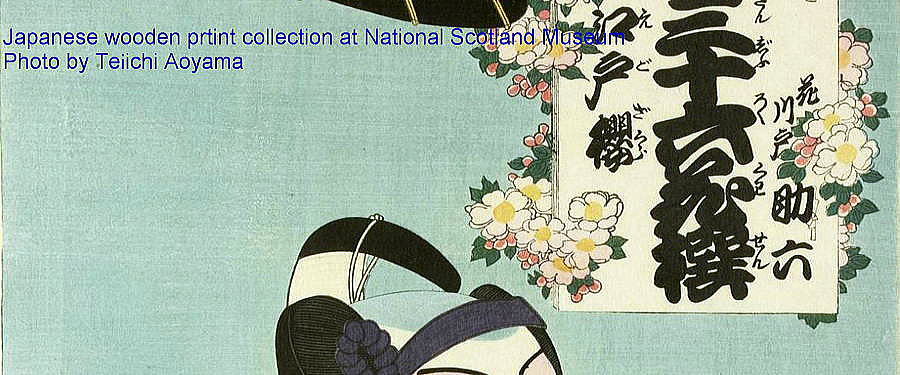 この美しい19世紀の版画は歌川国貞の作品とされており、役者初代河原崎権十郎が花川戸助六を演じているところを描いており、36選の一連の花柄の絵(「渡世見立三十六歌撰之内」)の一枚です。 This beautiful 19th century woodblock print by the acclaimed artist Utagawa Kunisada features the actor Kawarasaki Gonjruro I as Hanakawado Sukeroku, from the series Thirty-six Selected Floral Parallels (T?sei mitate sanjurokkasen). Source: National Museums Scotland  :権十郎の異母兄弟の兄、市川團十郎8世が景清を演じている様子を描いたもの。東海道五十三次のうちのひとつ。歌川国貞作 1852年。19世紀末、権十郎は、歌舞伎界の一大花形役のひとつとなり、近代化が広範囲に進む中で脅威にさらされた時代に芸術を救うと信じられていました。 Above: Gonjruros elder half-brother, Ichikawa Danjuro VIII, as Kagekiyo, from the series Tokaido gojusan-tsugi no uchi (53 Stations of the Tokaido) by Utagawa Kunisada, 1852.Gonjuro was to become one of the superstars of the Kabuki world during the late 19th century, credited with saving the art when it came under threat during a period of widespread modernisation. Source: National Museums Scotland  上:権十郎の父。市川海老蔵5世(前の団十郎7世)が渡世水滸伝編(近代の英雄たちの自伝を描いた作品)から幡随院長兵衛を演じている。歌川国貞作、1859年。30年後の1874年、権十郎は代々継承される名前、市川團十郎9世を受け継いだ。この伝統ある名跡はその前は、実父、そして異母兄弟の兄(団十郎8世)へと引き継がれていたが、20年以上その名前は使われていなかった。 Above: Gonjruro's father, Ichikawa Ebiz? V [previously Danjuro VII], as Banzui Chobei, from the series Tosei Suikoden (Biographies of Heroes for the Contemporary Age), by Utagawa Kunisada, 1859. Thirteen years later, in 1874, Gonjuro received the hereditary stage name Ichikawa Danjuro IX. This prestigious name had been held before him by his biological father and then his elder half-brother (Danjuro VIII), but its use had lapsed for more than twenty years. Source: National Museums Scotland 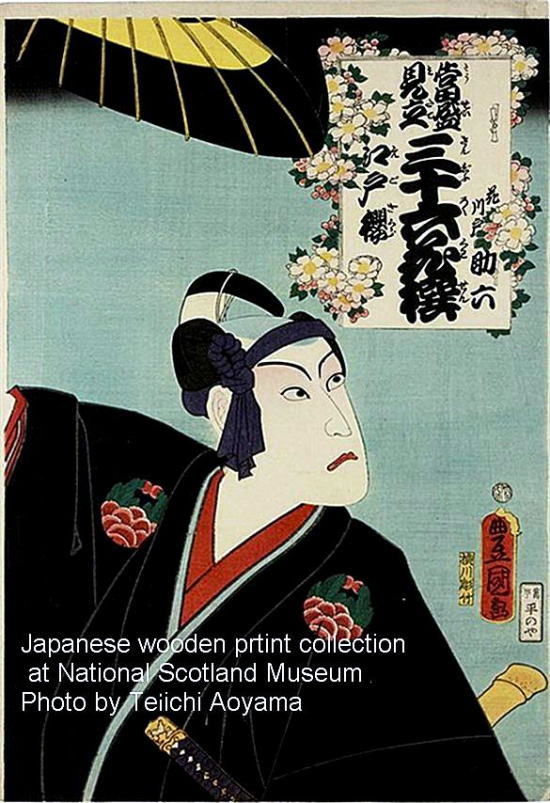 上:河原崎権十郎が三十六歌仙のうちの花川戸助六を演じている様子。(渡世見立三十六歌仙)助六は典型的な男前で江戸(現代の東京)で公式に認められていた遊郭、吉原で遊興し、この英雄は揚巻太夫と恋に落ちる。この演目は通常、桜の花が満開の時期に演じられることが多く、演目の文字盤にあるように、舞台は桜のモチーフで飾られている。助六は、傘を高く掲げてもっており、紫色の鉢巻、背中には尺八を背負っているのですぐに見分けることができる。ここは、吉原に入っていく場面であり、特に男前らしい丹前を身にまとって粋な格好で歩いて行く。このデザインは19世紀半ばの国貞の作品の中でも最も美しい作品の一つである。河原崎権十郎一世は、名高い俳優である市川團十郎7世の数名の息子の一人である。しかし、彼の両親は結婚して織らず、彼は他の演劇一家に養子に出されて育った。この絵が描かれた頃の彼は若く23歳だった。 Above: Kawarasaki Gonjro I as Hanakawado Sukeroku, from the series Thirty-six Selected Floral Parallels (T?sei mitate sanj?rokkasen).Sukeroku is the quintessential dandy, and the play is set in Yoshiwara, the licensed pleasure quarter in Edo (today's Tokyo), where the hero is in love with the courtesan Agemaki. The play was usually performed during cherry blossom season, and the stage was decorated with this motif, as seen here around the title cartouche. Sukeroku is instantly recognizable from the umbrella held high above his head, the purple headband, and the bamboo flute on his back. Here, he is making his grand entrance into Yoshiwara, where he moves with a particular dandy-like gait (called tanzen). This design is from one of the finest print series by the artist Kunisada, who dominated the production of actor prints during the middle decades of the 19th century.Kawarasaki Gonjuro I was one of several sons born to the famous actor Ichikawa Danjuro VII. However, his parents were not married and he was adopted into another theatrical family. At the time of this print, Gonjuro was a young man, 23 aged Source: National Museums Scotland 日本  19世紀初期の侍の鎧。 Early 19th century suit of Samurai armour. Source:the National Museum of Scotland 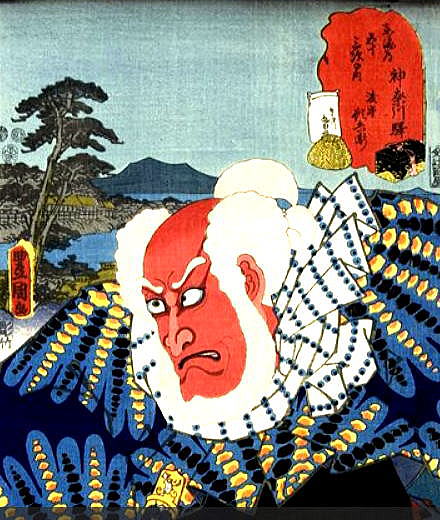 「品川」と題する色絵木版画。東海道五十三次のうちの一つ。歌舞伎役者である 市川海老蔵五世が「神霊矢口渡」で頓兵衛という渡船夫の役を演じている図。日本、宇田川国重、1852年。 Colour woodblock print entitled Shinagawa, from the series Tokaido gojusan-tsugi no uchi (53 Stations of the Tokaido), with the kabuki actor Ichikawa Ebizo V as Tonbei the ferryman, from the play Shinrei yaguchi no watashi: Japan, by Utagawa Kunisada, 1852. Source:the National Museum of Scotland 「 国立スコットランド博10」につづきます スコットランド総目次へ* |